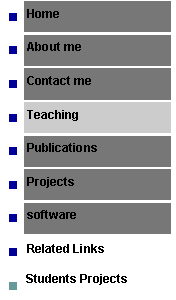|
Introduction to Grid Computing (2005-2007)
Content (1/2):
Course 1: Grid Middleware (Fundamentals of Grid Computing) Course 2: Service Oriented Architecture & Web Service Course 3: WS-Resource Framework Course 4: Grid Security System Course 5: Sun Cluster Grid Architecture (Sun Grid Engine Project) Course 6: Data Grid System Course 7: Unicore Project Course 8: Legion Project
NOTE: The content of this course has changed, the new content is published on the UvA Blackboard System, see the description in the UvA course Catalogue UvA Blackboard ... UvA course Catalogue ...
Course 1: Grid Middleware Fundamentals of Grid ComputingDate: 05-01-2005 Description: The objective of this lecture is to introduce some of the basic concepts of the Grid Technology. Among other topics addressed in this lecture are the types of resource targeted by the Grid technology, the different categories of the users of the Grid, and the problems and the concerns of each category of users. Keywords: Grid Technology, OGSA, WSRF Course material: Slides [PPT] References: V. Berstis, Fundamentals of Grid Computing IBM Redbooks paper
Course 2: A service Oriented Architecture & Web Service TechnologyDate: 07-01-2005 Description: The objective of this lecture is to discuss the Service Oriented Architecture (SOA), why it is becoming important, in which context it can be used, and what are the main components composing its architecture. The lecture presents the Web service as a case study of the SOA. Keywords: SOA, OGSA, WSRF, Course material: Slides [PPT] References: Paul A Moore Characteristics of a Service Oriented Architecture, staff.iryx.com David S. Linthicum 12 Steps to Implementing a Service Oriented Architecture staff.grandcentral.com Dan Gisolfi Web services architect, Part 1: An introduction to dynamic e-business staff.us/ibm.com Dan Gisolfi Web services architect, Part 2: An introduction to dynamic e-business staff.us/ibm.com Sotomayor Web service Tutorial http://staff.casa-sotomayor.net/gt3tutorial/core/service_data/sd_ogsa.html.
Course 3: WS-Resource FrameworkDate: 12-01-2005 Description: The WS-Resource construct has been proposed as a means of expressing the relationship between stateful resources and Web services. In this lecture, we introduce here the WS-Resource framework, and discuss the set of proposed Web services specifications composing the WS-Resource approach. The specifications describe the means by which a view of the state of the resource is defined and associated with a Web services description, forming the overall type definition of a WS-Resource. Keywords: WSRF, WS-ResourceProperties, WSResourceLifetime, WS-RenewableReferences, WS-ServiceGroup, and WS-BaseFaults Course material: Slides [PPT] References: Karl Czajkowski et al. The WS-Resource Framework Ian Foster et al. Modeling Stateful Resources with Web Services
Course 4: The Grid Security SystemDate: 14-01-2005 Description:.This course addresses the Security issues of the Grid Technology. For end-users, the primary requirement of the secure system is simplicity: Access to the virtual organization's resources should not be significantly different from access to the local organization's resources. There should be a single sign-on, where users need to log on only once to access all permitted resources. Programs running on a user's behalf should possess a subset of the user's rights and have access to the permitted resources. To support such a requirement the Grid security infrastructure must transparently interface. The course introduces the basic mechanisms on which the Grid security infrastructure is based. Keywords: PKI, Grid Credential, Multiple-security domains Course material: Slides [PPT] References: Randy Butler et al. "A National-Scale Authentication Infrastructure" Ian Foster et al. "A Security Architecture for Computational Grids" Von Welch et al. "Security for Grid Services" Laura Pearlman et al. "A community Authorization Service for Group Collaboration" Ian Foster et al. "Managing Security in High-Performance Distributed Computations"
Course 5: The Sun Cluster Grid Architecture (Sun Grid Engine Project)Date: 19-01-2005 Description: Keywords: three-tier system architecture, multi-host queues, Course material: Slides [PPT] References: Sun Cluster Grid Architecture A technical white paper describing the foundation of Sun Grid Computing Paulo Tibério Bulhões, et al. N1TM Grid Engine 6 Features & Capabilities
Course 6: The Unicore ProjectDate: 21-01-2005 Description:. Keywords: Job Abstraction object, Network job manager Course material: slides [PPT] References: UNICORE Plus Final Report Uniform Interface to Computing Resources M. Romberg. The UNICORE architecture: Seamless access to distributed resources. Proceedings of the 8th Int. Symposium on High Performance Distributed Computing HPDC-8, pp 287-293, Aug. 1999
Course 7: The Legion ProjectDate: 26-01-2005 Description:. Keywords: Object-based integrated system, top-down approach, and Grid OS Course material: Slides [PPT] References A. S. Grimshaw, et al. A philosophical and technical comparison of Legion and Globus Steve J. Chapin, et al. Resource Management in Legion Holly Dail et al. Application-Aware Scheduling of a Magnetohydrodynamics Application in the Legion Metasystem
Course 8: The Globus ProjectDate: 28-01-2005 Description Keywords: low level functionality, bottom-up approach Course material: Slides [PPT] References: Joseph Bester et al. GASS: A Data Movement and Access Service for Wide Area Computing Systems A. S. Grimshaw, et al. A philosophical and technical comparison of Legion and Globus
|



|
Workflow & Grid Middleware Group (WGM) |

